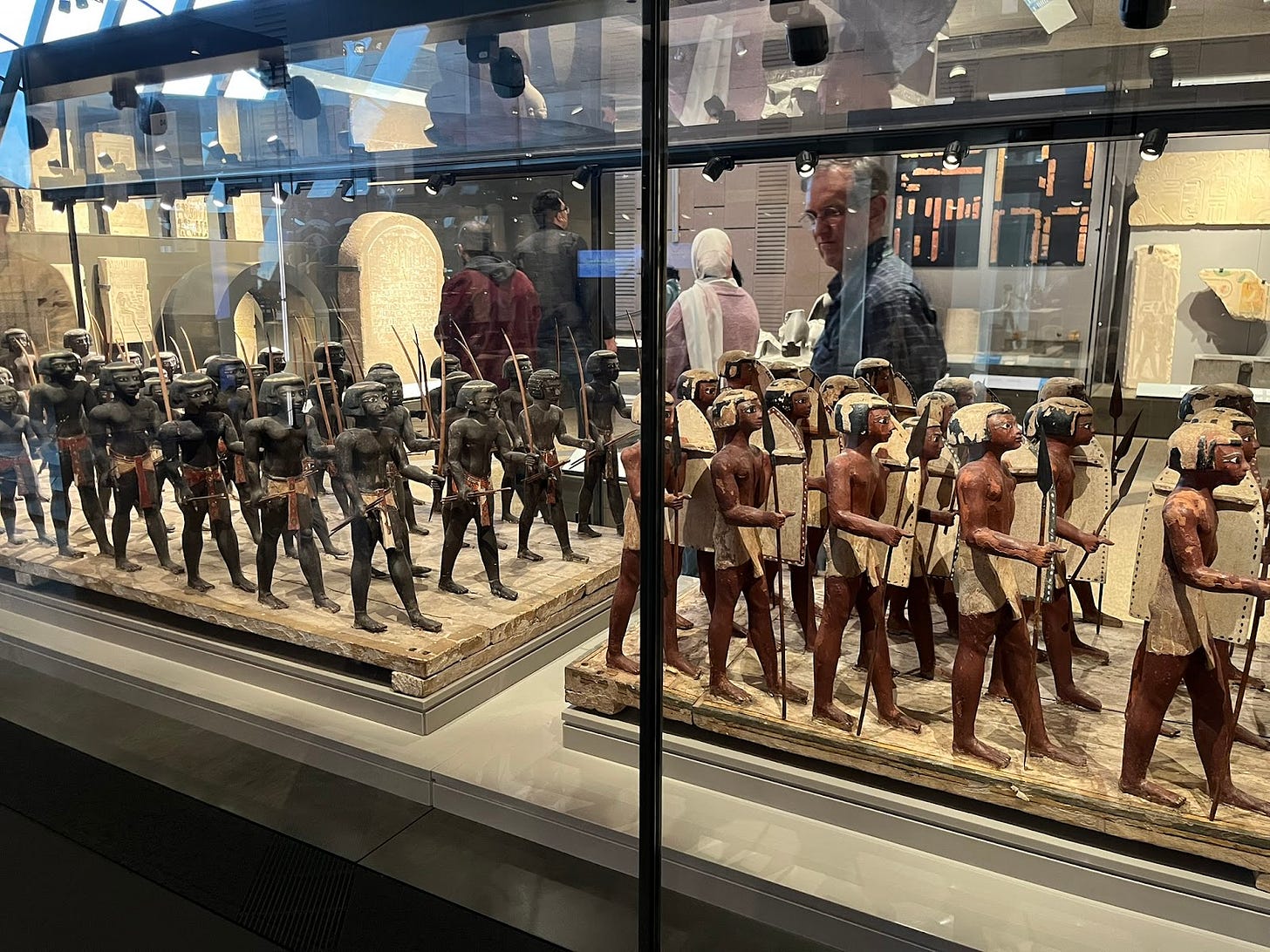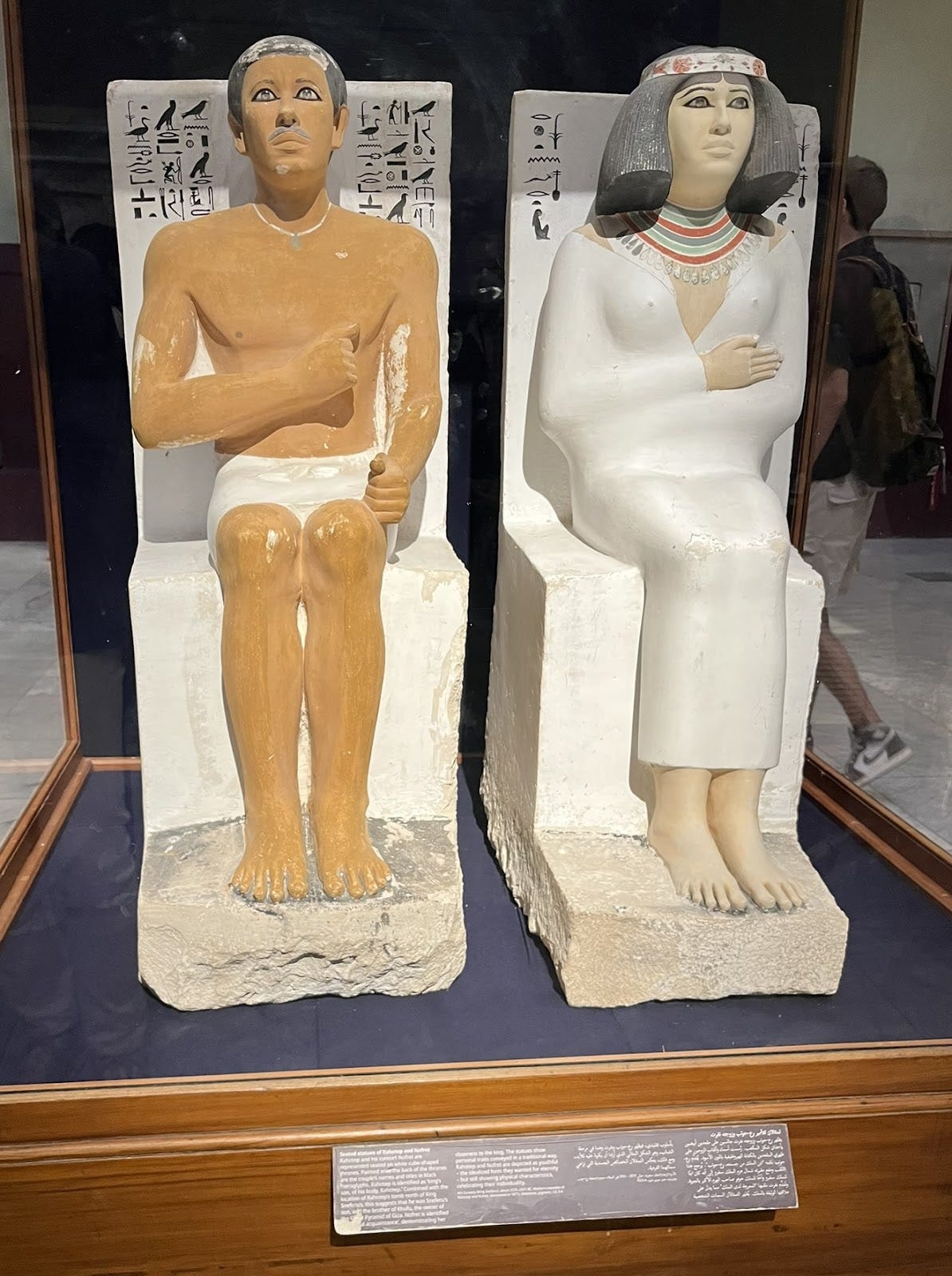When Mark and I returned from our recent trip to Egypt and Jordan, many friends asked: did you feel safe? Answer: yes. People were friendly and welcoming in both countries, and quite eager to have tourists because of the downturn since the start of the Israel-Hamas war.

It was surprising, however, that many tourist sites in both countries had armed guards. Several times we had a guard with us on our private tour bus, required by the government in an attempt to help tourists feel safe. It sort of had the opposite effect on me (what is the danger that requires a guy with a machine gun to guard me?!) If the war in Gaza or Syria extended to Egypt or Jordan, that guard wouldn’t protect us from bombs. But I wasn’t worried about that. And, as far as attacks that harm civilians or tourists, that’s happened more often in the U.S. than in Egypt or Jordan in recent years.
That thought led me to wonder whether, behind our friends’ questions about safety, there may be an implicit bias going on. Maybe it’s not just the recent war that has people nervous about going to the area; maybe it’s a subtle type of racism. Middle Easterners are different; many are Muslim; they might be dangerous? We still have movies portraying Arabs as evil villains, and that sinks into the culture.
We’re familiar with western racism against Arabs and Middle Easterners generally. But something I hadn’t thought about, before this trip, is racism within those Middle Eastern countries. In the case of Jordan, there’s discrimination against people of Palestinian origin, by the people who consider themselves the original Jordanians: members of Bedouin or other tribes. National identity and pride in Jordan is strongly connected with tribal heritage.
Jordanians may look similar, but their last names reveal their origin. Tribal members have similar last names, and different tribes have different status in society. But apparently tribal members all have higher status in today’s Jordan than citizens who originally came from Palestine, and that is also indicated by their last names. It’s sort of like in the U.S., making status assumptions about people with last names of Garcia instead of Winslow.
There are almost three million Palestinians in Jordan, making up half the country’s population. Most are Jordanian citizens, but have faced various forms of discrimination over the years by the Jordanian government or its tribal citizens. Almost 200,000 are stateless refugees, meaning they have no citizenship in any country.1
The recent Israel-Hamas war has led to protests in Jordan, including by many Palestinian Jordanians, because Jordan has a peace treaty with Israel, and has historically had close ties with the U.S. and the west in general. The Jordanian government fears that Israel will try to push large numbers of Palestinians to Jordan from Gaza and the West Bank, so Jordan no longer accepts any Palestinian refugees. In fact, Trump just suggested on January 25th that Gazans be moved to Jordan and Egypt, a proposal that both countries quickly rejected.
Jordan also has large numbers of refugees from Syria, Lebanon, and Iraq. It’s a safe haven, a stable country surrounded by unstable places (see On Kings and other Things). Whether those refugees feel welcome is another issue, one faced by our own country and so many others. There are over a million immigrants from Syria in Jordan, most of whom are refugees, and who also face discrimination and difficulty getting jobs.
Egypt is a different story. Until this trip, I didn’t know anything about the Nubians. (This happens to me so often: I learn stuff while traveling that I feel I should have known). Before we saw any of the tombs or temples, we visited both major museums of ancient Egyptian artifacts (see Funky Tut and the Afterlife). We saw tiny models of armies that were entombed with pharaohs to accompany and protect them in the afterlife, and these armies had different skin colors. The dark soldiers were Nubian.

Then when we visited tombs in the Valley of the Kings, we saw wall paintings depicting the conquering pharaoh, and captives who had been beheaded or were tied together with ropes. The victorious Egyptians are shown with light-brown or reddish skin, but the captives are either darker red or black-skinned. The dark red ones were apparently “Asian” (probably near-East, from the Mesopotamia area), and the black ones were Nubian.
The Nubians lived – and still live– in what’s now southern Egypt and northern Sudan. Many Nubians were displaced from their homes during the building of the Aswan Dam in the 1960’s, which created the enormous Lake Nasser, flooding the entire area. Some Nubians went north to Cairo, some to the desert, some left the country. Today only 1-3% of Egyptians are Nubians. Our group travelled to southern Egypt to Lake Nassar and the Aswan dam; people there generally had much darker skin than in the Cairo area.
Historians agree that there were Nubian/Kushite pharaohs of Egypt (in the 25th dynasty, or 8th c. BC). Nubians also sometimes held high positions of power under other pharaohs. But for much of Egypt’s history, they were considered enemy peoples. Since at least the beginning of the 20th century, Nubians have faced extensive discrimination in Egypt, including through physical displacement by the government, discrimination in job opportunities, and negative portrayals in film and other media.
Most of us are quite familiar with the racism that exists in our own country (although, as a White person, I’m of course not as aware as people of color are). I am always a bit surprised to find racism in other countries. Then I sadly realize that people who have minority status usually always have it bad.
Another interesting thing we noticed on the ancient paintings and sculptures is that men were often depicted with darker skin than women. Scholars believe this is because women in ancient Egypt spent more time indoors. Rather than reflecting our modern sensibilities about skin color hierarchy, these sculptures are an example of the meticulous detail of the ancient artists.

I learned that Egypt has always occupied a unique slot in western ideas about race. When “Egyptology” became the rage in the 19th and early 20th centuries (when western explorers and archeologists started finding and plundering the tombs), American writers described ancient Egyptians as not only very civilized but also light-skinned, in contrast to the sub-Saharan Africans whom we were enslaving.2 In more recent decades there was a backlash, with some writers arguing that ancient Egyptians were Black like sub-Saharan Africans. Most modern historians, however, believe that ancient Egyptians had a range of skin colors from light to dark, just as they do today. In 2022, DNA testing of mummies from 1400 BC- 400 AD revealed that those ancient Egyptians were most closely related to the eastern Mediterranean people of the Levant (like those captives shown with dark-red skin).
But these Western ideas separating Egypt from the rest of Africa reveal underlying assumptions that “African” people couldn’t develop great empires and that “African” identity is defined by skin color, as opposed to geography. The fact that many White westerners don’t see Egypt as “African” may reflect the assumption that “Africans” are dark-skinned; since Egyptians are lighter-skinned, we’ll call them Middle Eastern.
Although Egypt is located on the African continent, it is often considered part of the Middle East, not part of Africa. It’s true that, historically, Egypt was very involved with other Mediterranean countries, as it shares a coast on that sea. In my own lifetime, Egypt has been very involved in Middle East geopolitics. But of course Egypt is an African nation, as part of the African continent. It was one of the founding members of the African Union. (This reminds me of my friend who corrects me every time I use the term “American” to refer to people from the U.S. – she’s from Colombia and is also American, just from South America instead of North America.)
I also found it fascinating that in Egypt some of the Black members of our tour group received unusual attention. One woman noted that groups of schoolchildren were staring at her, fascinated. The children may not have seen many Black tourists from abroad. It reminded me of being off the beaten trail in Cambodia or Rwanda, when children stared at Mark and I, white faces in a land of darker skin. Those children hadn’t seen many tourists at all. But here it was the opposite; these children may have been amazed that some western tourists looked like them. There were also adult Egyptians, especially in the south of the country, who were openly excited and welcoming to our Black friends (“Hey, brother!”).
Travel takes us out of our usual community, our everyday lives, and sometimes we experience being seen differently by people. Sometimes we are seen as Other. Sometimes we are welcomed as family. But one thing I like is the broadening of my own perspective – the chance to get to know people of different cultures and different countries, and to recognize in them our shared humanity – and not to see them as Other.
It gives me a lot to think about.
Photos by Jill Martin
Previous Posts on Egypt and Jordan:
Mut, Moses, Mary, and Muhammad
Sources, or for Further Reading:
Jordan - Tribes and Tribalism Are Jordan’s government and pro-Palestinian protesters facing off? | Israel-Palestine conflict News | Al Jazeera Jordan’s Redline on Admitting Palestinians Is Unlikely to Change | Carnegie Endowment for International Peace https://carnegieendowment.org/sada/2024/01/syrian-refugees-in-jordan-a-crisis-of-dwindling-humanitarian-aid?lang=en https://apnews.com/article/israel-palestinians-trump-gaza-egypt-jordan-c6bedbd6ca0702c22b80f1bf07cd4326 https://en.wikipedia.org/wiki/Black_September#:~:text=Black%20September%20(Arabic%3A%20%D8%A3%D9%8A%D9%84%D9%88%D9%84%20%D8%A7%D9%84%D8%A3%D8%B3%D9%88%D8%AF,led%20by%20chairman%20Yasser%20Arafat https://www.thecollector.com/were-ancient-egyptians-black/ Egyptian Media: A Catalyst for Racism against Nubians - Media Diversity Institute DNA discovery reveals relatives of ancient Egyptians | CNN https://bigthink.com/surprising-science/were-the-ancient-egyptians-black-or-white-scientists-now-know/ The Message, Ta-Nehisi Coates, BCP Literary Inc. (2024)
Jordan has a roller-coaster history with the Palestinian cause. In 1970, the “Black September” war erupted when Arafat set up a large PLO presence in Jordan and called for the overthrow of the Hashemite monarchy. Syria came to the aid of the PLO. The late King Hussein used the army to forcibly oust the PLO from the country. Later, after the King renounced claims to the West Bank in 1988, Jordan supported PLO efforts to establish a Palestinian state. The peace treaty that Jordan signed with Israel in 1994 enshrined Jordan’s role as guardian of holy places in East Jerusalem, causing tensions with the PLO to rise again.
There is an excellent discussion of this period in The Message by Ta-Nehisi Coates, pp. 29-35.






